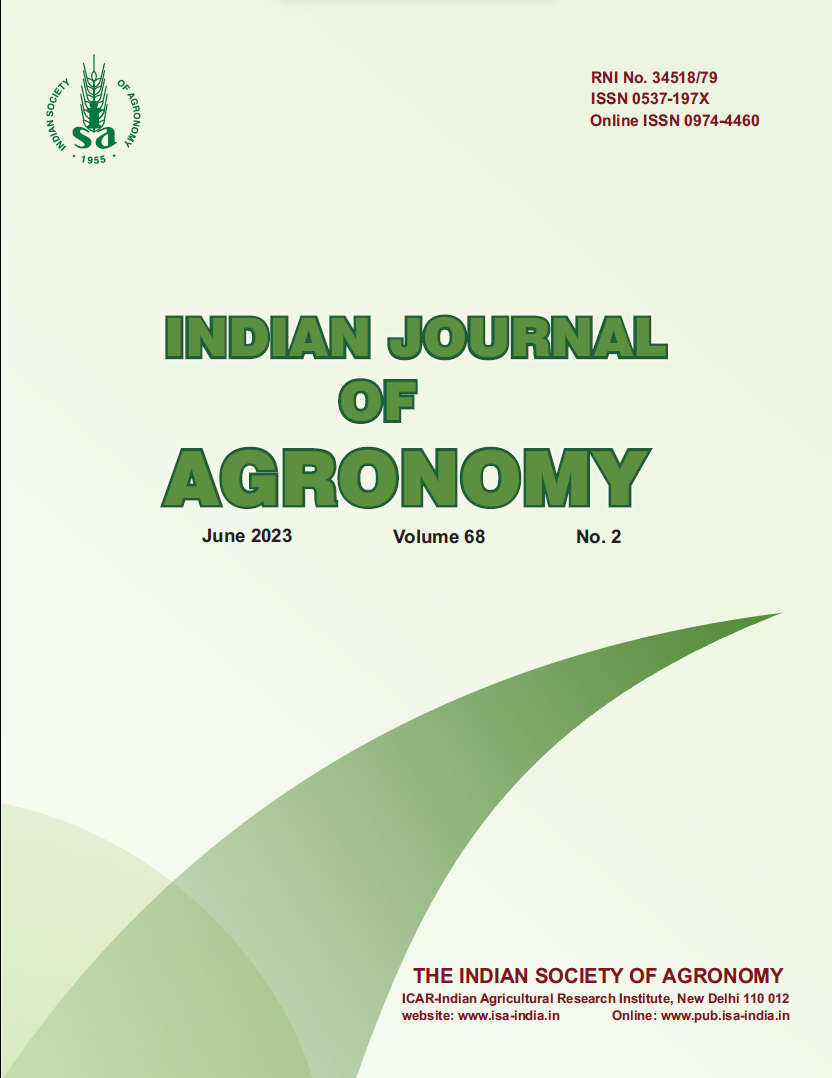Influence of phosphorus and biofertilizers on symbiotic parameters, productivity and profitability of soybean (Glycine max)
DOI:
https://doi.org/10.59797/ija.v68i2.366Keywords:
Biofertilizers, Phosphorus, Seed yield, Soybean, Symbiotic parametersAbstract
A field study was carried out during the rainy (kharif) season of 2019 at the Regional Research Station, Punjab Agricultural University, Ludhiana and Faridkot, Punjab, to study the effect of phosphorus levels and biofertilizers on the symbiotic parameters, productivity, and profitability of soybean [Glycine max (L.) Merr.]. The experiment comprised 4 phosphorus levels (0, 17, 26 and 35 kg P/ha) and 4 biofertilizer treatments [uninoculated control, Bradyrhizobium, Phosphate-solubilizing bacteria (PSB) and Bradyrhizobium + PSB]. Total 16 treatment combinations were laid out in a factorial randomized complete-block design, replicated 3 times. Application of 35 kg P/ha recorded the highest symbiotic parameters, growth and yield attributes and seed yield of 2 and 1.84 t/ha at Ludhiana and Faridkot, respectively, which were significantly higher than the control and 17 kg P/ha but statistically at par with 26 kg P/ha at both the locations. However, the highest production efficiency (14.62 and 13.50 kg/ ha/day at Ludhiana and Faridkot, respectively) was recorded with application of 35 kg P/ha, being statistically at par with 26 kg P/ha. The highest monetary efficiency (302 and 277 `/ha/day at Ludhiana and Faridkot, respectively) was obtained with the application of 35 kg P/ha which were at par with 26 and 17 kg P/ha at Ludhiana, while with 26 kg P/ha at Faridkot. Inoculation with Bradyrhizobium + PSB and sole inoculation of PSB were at par with each other and both proved superior to uninoculated control for growth and yield attributes, seed yield and monetary efficiency.
References
Dass, A. and Bhattacharyya, R. 2017. Wheat residue mulch and antitransparent improve productivity and quality of rainfed soybean in semi-arid north-Indian plains. Field Crops Research 2010: 9–19.
Dass, A., Raj, R., Vyas, A.K. and Kumar, S. 2016. Improved cultivation practices for soybean. Indian Farming 66(2): 10–13.
Dass, A., Dey, D., Lal, S.K. and Rajanna, G.A. 2019. Tank-mix insecticide and herbicide application effects on weeds, insectpest menace and soybean productivity in semi-arid northern plains of India. Legume Research 42(3): 385–391.
Hasanain, M., Singh, V.K., Rathore, S.S., Shekhawat, K., Singh, R.K., Dwivedi, B.S., Upadhyaya, P.K. and Singh. 2021. Effect of site-specific nutrient management in conservation agriculture-based maize in north-western India. Indian Journal of Agronomy 66(2): 136–142.
Jain, P.C. and Trivedi, S.K. 2005. Response of soybean (Glycine max L.) to phosphorus and biofertilizers. Legume Research 28: 30–33.
Jaybhay, S.A., Taware, S.P. and Varghese, P. 2017. Microbial inoculation of Rhizobium and phosphate-solubilizing bacteria along with inorganic fertilizers for sustainable yield of soybean [Glycine max (L.) Merrill]. Journal of Plant Nutrition 40: 2,209–2,216.
Kumawat, R., Ram, B., Singh, P., Tetarwal, J.P., Yadav, R.K., Gupta, A.K. and Bijarnia, A. 2022. Response of summer mungbean (Vigna radiata) to phosphorus levels, biophosliquid biofertilizer and growth-regulator. Indian Journal of Agronomy 67(2): 170–174.
Nandini, K., Singh, L.N.K., Devi, H.N., Singh, T.B., Singh, K.K. and Singh, W.M. 2012. Response of soybean [Glycine max (L.) Merrril] to sources and level of phosphorus. Journal of Agricultural Sciences 4: 44–53.
Rajanna, G.A., Dass A., Suman A., Babu, S., Venkatesh P., Singh, V.K., Upadhyay, P.K. and Sudhishri, S. 2022. Co-implementation of tillage, irrigation, and fertilizers in soybean: Impact on crop productivity, soil moisture, and soil microbial dynamics. Field Crops Research 288: 108,672.
Salvagiotti, F., Cassman, K.G., Specht, J.E., Walters, D.T., Weiss, A. and Dobermann, A. 2008. Nitrogen uptake, fixation and response of fertilizer N in soybeans: A review. Field Crops Research 108: 1–13.
Virk, H.K., Singh, G. and Sharma, P. 2018. Symbiotic parameters, growth, nutrient uptake as influenced by biofertilizers under conservation agriculture practices. Proceedings of the National Academy of Sciences India Section B: Biological Science 88: 1,453–1,461.
Virk, H.K., Singh, G. and Sharma, P. 2017. Productivity, nutrient uptake, energy indices and profitability of soybean (Glycine max) as influenced by planting methods, Bradyrhizobium and plant growth promoting rhizobacteria. Indian Journal of Agronomy 62: 341–347.
Wilson, D.O. and Reisenauer, H.M. 1963. Determination of leghaemoglobin in legume nodules. Analytical Biochemistry 6: 27–30.






